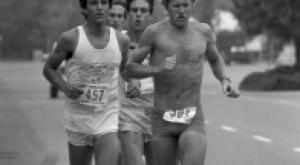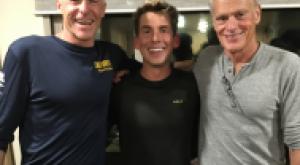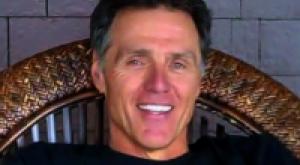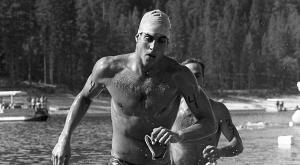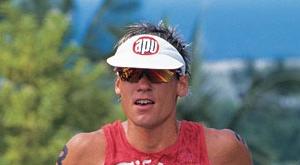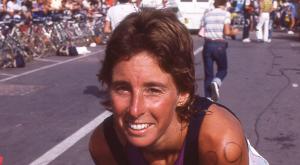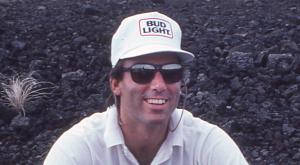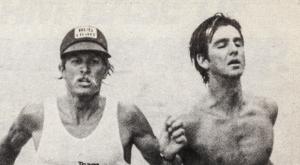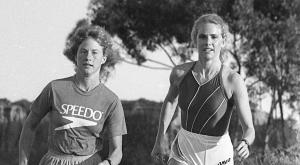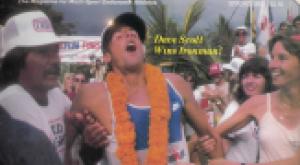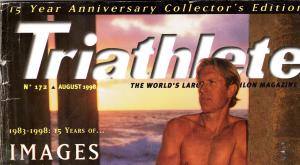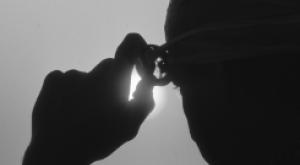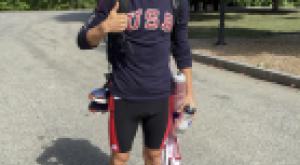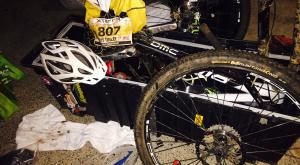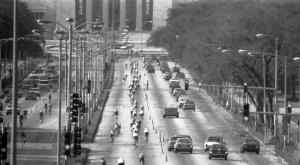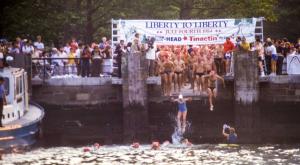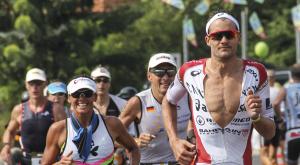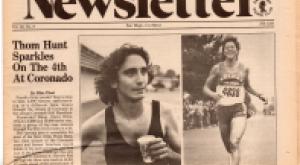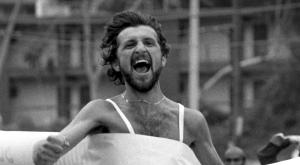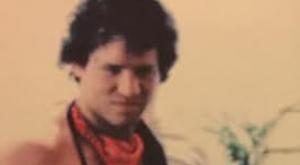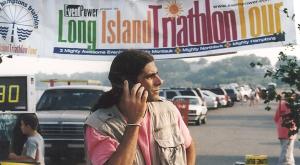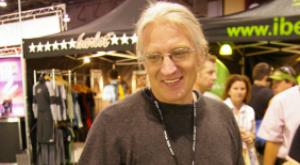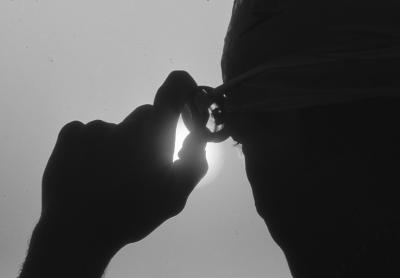
To mark the recent 40th Anniversary of the IIonman World Triathlon Championship in Kona, Hawaii, I wanted to offer a survey of ideas and thoughts about the event I’ve penned over the past decades. But when I went through old files, most of the what I’d written was about the town of Kona and its amazing people. The reconstituted essay below first appeared in my book, Finding Triathlon: How Endurance Sports Explains the World (Hatherleigh, 2015). I believe it most accurately sums my feelings about my 20-year affair with this town, its people, and the events that brought us together. -- ST
The white lava rocks that are used as pieces of physical graffiti against the black background on this billboard-banned road claim that, “Jesus Saves.” It is written in stone and then sub-titled, “Now go home, haole.”
The Ironman course in Kona is not so much a place as it is a region. Its length -- 144 miles plus or minus a few orange traffic cones, is steeped in cultural history, much of it dark. The town of Kailua-Kona where the event begins and ends encompasses 39.8 square miles. A little over four square miles or roughly 10.7% is, fittingly, underwater. As you leave the town that served as a seat of government for King Kamehameha I in the late 17th and early 18th centuries and head north on the highway along the Kohala Coast, there are a handful of palms trees, some struggling roadside bougainvillea, and tropical scrub. The debutante visitors scan the hills for thin waterfalls and taxi drivers divert projective volcanic orgasms onto the thick burn-pile smoke at the County Dump.
“Ho, Brah…look Ol Pele doin her ting agin. Whole volcano gonna blow soon. But I keepa you kine safe."
Kamehameha I, who died in 1819, is also known as the first King of Hawaii. His early gig as royalty was in protecting Kuka’ilimoku, the Hawaiian god of war, from invading tribes from other parts of Polynesia. How do you protect a ghost? Sounds like a good gig. Kamehameha’s full Hawaiian name is Kalani Paiʻea Wohi o Kaleikini Kealiʻikui Kamehameha o ʻIolani i Kaiwikapu kaui Ka Liholiho Kūnuiākea.
Say that twice after two mai tais at the Kona Inn.
When the Ironman triathlon was first brought to the town of Kailua-Kona from a crowded Oahu in 1981, the town was growing up and out but slowly, like a bad haircut.
If you look closer at Kona’s scalp, you can see the remnants of ancient and modern warriors, pieces of flesh and bone that constitute the unnerving vibrations of the region. I first met Pat Griskus in 1985. Pat had lost a leg in a 1967 motorcycle accident and became the first amputee/athlete to complete the Ironman. In his late 20s, the single-leg amputee from Boston was well-liked, well-adjusted to his physical challenge, and well… a damn good athlete. In 1986, the day after I had been misanthropically heartbroken by a third-place finish to Dave Scott and Mark Allen, Pat had looked me in the eye and said, “Tinley, you have so much to learn about life.”
The following October I looked for Pat in town on race week. I wanted to tell him he was so right. But as Pat was cycling back into Kona, four days before the event, a nice, easy, taper-ride on the long strip of asphalt known as the Ka ‘ahumanu or “Queen K” Highway, a heavy metal trough with reinforcing iron particles attached to the stern of a cement truck inexplicably swung out to the side of the vehicle, into the road’s shoulder, and the back of Griskus’ helmeted-skull. He was dead by the time following cyclists cradled the man in their arms. It was a strange accident, everyone agreed, a tragic incident. The race went on as scheduled.
Nothing comes easy in this town, least of all redemption. Though many come to seek it.
Randy Caddell was 37, a paraplegic, a local Kona resident, and seven-time Ironman veteran. Calling himself, “The Animal,” Caddell had suffered his first disabling injury in a motorcycle accident near Hollister, California -- a town made famous as the setting of Stanley Kramer’s 1953 movie, The Wild One, starring Marlon Brando.
Pedaling a hand-crank, three-wheel cycle specifically designed for upper body-abled paraplegics, Caddell apparently was struck from behind by the turning vehicle of a fellow triathlete. No blame was ever assigned in The Animal’s death. It was a tragedy, most agreed, and as long-time Ironman Medical Director, Dr. Bob Laird said, “a true accident.”
When I heard the news on March 1st, 2005, I thought of Brando’s character from the film, Johnny Strabler. When asked by the town’s police chief, “What are you all rebelling against?” the young Brando replied, “What do you got?”
Caddell, for his part, was known in local Kona circles as a talented glass blower. Sand, the one thing that most tourists note a dearth of in Kona, is the primary ingredient in glass. Dust to dust.
******
Over on the other side of the Big Island, the periodic lava flows from an erupting Mt. Kilauea are adding to the size of the island as they reach the sea and extend the shore. But miles of man-built and paved roads have been buried under the molten flows as well. The human access to the natural world is necessarily cut off by nature. No one rides their bike on this part of the island.
“The whole island is rife with chaos and creativity,” Jim MacLaren, an Ironman finisher, Kona resident, and partial quadriplegic, told me in 2007. “Athletes of all abilities go there to find themselves, to be reborn. But some of them get eaten up by the powerful energy that exists on the Island.”
Jim pauses just long enough to remind me that he might not be able wait around long enough for me to decide the right time and place to put his powerful words into print. I remind Jim that The Fates are firmly on his side now. He has paid his due for anything his ancestors had ever done wrong.
And then some.
On Tuesday, August 31st, the year of 2010, sometime in the early evening as the sun was setting over Kona, a 47-year-old MacLaren would submit to the vicissitudes of human pathos; his time in Kona both his salvation and the tumultuous centrifuge of his life.
The good they die young.
What MacLaren’s life explicates each October, when many hundreds of the best triathletes in the world envelop the town to compete in the Ironman World Championship, is that most of them don’t having a fucking clue about this island. In comparison to similar iconic endurance events, a higher percentage of athletes experience either the best or worst race of their career. Banality in anything is rare on the Big Island. Locals become either fiercely loyal to or vehemently against, the Ironman.
The Big Island of Hawaii and its inhabitants are always and already becoming something new and different.
******
The West Coat of Hawaii, traced all the way to King Kamehameha’s rule, has been a place of refuge for those wanting to escape the oppression in their lives. Athletes come here, as MacLaren claimed, “to find a new map of their lives.” As the populations of Kona, Ironmen, and shifting ideologies grow, so did the polarity.
Polarized magnets that can’t quite align with each other.
In the middle of the island sits Muana Kea, the tallest island mountain in the world (over 32,000 ft. from the ocean floor to the top). The island of Hawaii is geographically isolated and young. Significant things happen here all the time. Nobody lives small and everybody seems to be somehow defined by their wound or their victory-- mythological figures with an axe to grind or a spear to throw.
And even if Kona only exists as some tropical Valhalla for athletic searchers and nouveau riche retirees, it’s a big island; you’d think there’d be enough room to spread out. Or maybe the sheer size is daunting to those who subconsciously seek community among the like-minded and flock to the small towns or pop-up resorts where the lava has been replaced with India’s imported sand and manicured fairways and ocean-front homes valued in the many millions.
Still, nobody in Kona stays indoors. It’s Hawaii, for Christ’s sake, regardless of your reason for being there you feel the pull to be outdoors and on the move. And much of the time, the Queen K is your only route.
To heaven or to the crossroads she will take you.
Jim Major, a local Wailuku singer-songwriter who has braved traffic snarls in such frenetic metro-zones as New York City, South Boston, and Washington, D.C., thinks the Queen K Highway is the most dangerous stretch of roadway he has ever been subjected to.
“The road was paved over miles of native bones and lost cities” he offers. “The whole road is unpredictable, the asphalt moves. Just today there was a head-on collision with three fatalities. I’m scared to drive the ten miles to work.”
You hear the edge in his voice and want to peak over but not jump. The refrain pulls you back and reminds you that art heals all. Like the ancient Hawaiians, like Jim MacLaren, who moved to Kona in a wheelchair to “Rekindle the feeling of what I had accomplished when I was only a single-leg amputee,” maybe the two Jims were just seeking refuge for a while, until the earth beneath them stopped moving.
“Almost every athlete who gravitates to Kona is already wounded,” claimed MacLaren. “Metaphorically, many of them are already in a kind of wheelchair.”
"But Jim(s),” I had to ask both of them, “why do we wait until the once-bitten are finally swallowed whole before we take notice? Is it that when an emotionally or physically challenged artist or athlete, after fighting the good fight and inspiring able-bodied hearts and minds with their strength of will and unvanquished tenacity, finally comes up against a foe too fast and with too much towing capacity, that we take greater notice of their demise?”
“It puts it right in your face,” MacLaren offered. “When someone physically half-dead is finished off. There is something about the place that makes you feel immortal and close to death at the same time. That’s why I raced in Kona, why I moved there, why I allowed myself to get hooked on drugs there…and why I moved back to the Mainland to put my life back together.”
For Jim Major, who has endured more familial tragedy than a Matt Damon film, there is his art. On stage he loses himself in every musical piece of his historicity, including the rumor that his father was murdered by the Boston Mob. The Patron, urban legend has it, feeling bad about little Jimmy, made sure he was taken care of, had shoes and a music teacher. So, Jim Major began singing in the Southie subways and people noticed. He wasn’t just some punk from the neighborhood. This cat was the real deal.
Jim Major is a very, very good musician. If he lived in Nashville or Los Angeles or NYC he would play at hip clubs and small arenas. Still, Jimmy was redeemed as one of the best and most unheralded singer/ songwriters in Hawaii. A guy with no record contract who is better than most who have one.
So what? He made it out alive.
I wondered if this was the same thing that happens when a series of earth moving trucks headed out on to the Queen K Highway to build one more posh resort, the thick rush of their heavy loads of imported red earth and the thump-thump of the big diesel motors passes uncomfortably close to a group of cyclists or runners or tourists in paper-thin sub-compact rental cars. Are people in Kona redeemed simply by living to tell about it? Seventeen-hour Ironmen and women will walk the first and last thirteen miles of the marathon. But they will sprint the final .2 and make the local 6 o’clock news in their hometown.
Who can know when they are saved or just offered another coupon for a discount at the ABC Store on Kuakini Street?
Nothing in Kona is as it seems though; not the lack of dense green foliage found throughout the other islands, not the long and sometimes lonely, sometimes grid-locked ribbons of asphalt road where ghost cars come out of the mist, not even the very earth that shifts with each rumbling, faulted-breath that is either a land trying to find itself or Pele, goddess of volcanic fire, playing another bad joke.
******
Nick Rott was the founder and owner of B&L Bikes in Kona and perhaps the best example of Ohana and Aloha ever seen in one haole. Nick gave tirelessly to the burgeoning triathlon community. For many years I would park myself in the service bay of his shop during the few days preceding the Ironman just to see how patient a man could be. The Euro contingency had arrived in full at Kona during the early 90s and they needed their bikes perfect and they needed them now, goddammit, not in 10 minutes. Nick would offer them a seat, a cup of Kona coffee, and methodically go through each of their uber-vehicles as if it was his own.
On a simple training ride in 1994, Nick Rott, a man of infinite patience and care, was hit from behind by a car as he changed lanes, perhaps too early or too late. He died instantly. Nicky never quite adjusted to the coming crowds.
For those in the know, the best triathlon held on the island each year is not the Ironman or its derivatives but the LavaMan; a boutique, kama aina, no ka oi event produced by Nick’s widow, Gerry. At the event you can see soon-to-be famous musicians such as Jim Major playing at the awards with their race numbers still written on their arms and legs. If you ask, Jimmy will invite you onstage to sing lead so long as you are authentic to your own art.
In many ways, Kona and its surrounding roads are indeed Babylonian--paradise with a price, a place where you have to watch your back for reasons other than sunburn.
But even here, the nightmares can look and feel like sweet, rewarding sleep.

View from the Queen Kaahumanu Highway (Photo by Peter Kun Frary. Used with permission)
Somebody told me the other day that the entry fee for the New York Ironman was nearly a thousand bucks. That’s a big pile of sheckles, I tested him. That could buy you and a loved one a weekend away or a decent little mountain bike with a front fork that works for a year or two. He told me he’d rather work a few extra days instead of sitting around the house looking at that Ironman race application on the kitchen table, never even considering the fee in his decision on whether he will put his name on the top of that sheet.
I told him with that attitude, he’s already racing.
The first few Ironman races I did in Hawaii cost me a hundred even, more than my late 70s college tuition for the semester, books not included. Still, it didn’t matter. It was just something that I had to do. I worked a few extra days, sold my eight-track car stereo---I was going to be an Ironman. No need for anyone’s voice to validate the stamp.
Turns out I wasn’t alone. Seems to me quite a few people are compelled by this Ironman thing. Nowadays, you have to be very fast, very rich, or very lucky to snag a spot.
You ever wonder what regular people think when they hear that close to 20,000 people are somehow trying to get an entry into Kona? They must go home to their husbands and wives, dogs and friends and say something? I just don’t picture them leaving it alone, thinking that all those people must have a screw loose. I’d bet a thousand sit-ups that more than a few dream about crossing that finish line, all tan and trim, the crowd screaming their names, their toothpaste commercial smiles caught and beamed out over the airwaves. Heady shit.
And I’d bet when they wake up and get ready to put their pants or their skirts on in the morning, more than a few will roll over, mash their faces back into the pillow, trying to hide some sickening straight truth from the reality of the day and the gnawing feeling in their gut, wishing they had that same screw loose.
Maybe they realize that too many of us die too young or too late. Or too incomplete. Maybe they know that we pull ourselves up by making money, making love, making the grade; all the while making less and less time to face the fact that there are some things in life we need to do.
Just because.
I think the Ironman is one of those things.
Funny how the passion industry has morphed from the world’s oldest profession into one that catalyzes M-dot tattoos on hairless human leg calves.
I can’t pretend to know why for all those people. Hell, I barely have an idea why I did close to fifty of them. But I know that people are changed by an Ironman event. All finishers do. Ironman finishers are the kind who leave a mark on the world. Not the kind who get left a mark on.
Try to define that. Go ahead. The words will never come. It is enough to hear the stories, to watch the returning smiles. Witness the metamorphosis.
Yeah, there is a price too. Always is for the good stuff. Relationships, jobs, sunburn, toenails, a few hours of sleep. Heck, you do enough of them, maybe it’s a few years of life. At this point though, not too many people are doing a cost/benefit analysis. The call of the distant drum is too loud to ignore, too powerful to pawn off as some midlife crisis for the middle manager or desperate wanting plea from the minivan-bound soccer mom to grab her own life back for a day or two. They know they might be contextually bound by the reality of homework and staff meetings that await them beyond the finish line. Willing to pay the price, scared but thrilled, knowing, as Thoreau said, “as if you could kill time without injuring eternity.”
All they want is their One Day. But then it becomes so much more.
P.Z. Pearce, M.D. has been the Assistant Medical Director at Ironman for nearly 20 years. He knows more about the functions, effects, complications, and medical contradictions of Ironman competition than arguably any exercise scientist on the planet. If you want to separate fact from fiction in the physical culture of endurance sports, Doctor Pearce is your man. He and Ironman Medical Director, Bob Laird, Drs. Hiller, Massimino, O’Toole, Sallis and a host of great scientists have been collecting IM finish line data for decades and have amassed what might constitute several capacious volumes of telling material. But don’t expect these medical journals anytime soon. According to a former senior executive at World Triathlon Corporation, owners of the event and the brand, WTC will never release the data. The science, it was offered, might run roughshod on the Dream. Too much of good thing is still too much.
Sometimes truth sets you free and sometimes it places you in a jail of your own making. But I can’t fault the subjective. It is what empowered me and my pals for decades. Perhaps rationality is over-rated.
One day, enough intangible feeling and power of emotion to last for years, enhancing, not injuring eternity. And then accepting the costs.
But like war, marriage, tight jeans, and stick shift cars, the Ironman isn’t for everybody. As much as it can give, it can take away. If it was easy, it wouldn’t mean the same. Even dreams can be negotiated in the forecast of one’s decisions. But not after. The backlogs of medical data on Ironman finishers--good, bad, or ugly—will someday be available, titrated to judge effect on the dream that powers the profit.
I know there are other ways to validate one’s life. Has to be. The Pulitzer Prize winning author, Katherine Anne Porter, once said that salvation can only be found through religion and art. I believe that great feats of physical endurance include traits of both. The spirit of God and the spirit of creating something--if you believe--one made you and the other challenges you to make someone/thing else.
This is the kind of metaphysical place that the subject of Ironman creates for you. Go figure.
And in a world that tries its hardest to separate us from what should matter, the Ironman helps us reconnect with the pulse of our lives. As long as it does that, we will stand in that line, happy to have made the decision to embrace the heavy costs of that dream.

Ironman is not an education or a degree or a statement of purpose. It is a private transaction that you have with yourself. It occurs mostly on the one day. But if you've ever done it before, you know that in the end, there is no end. The constellation of feelings brought up by your Ironman experience will follow you around like a lost dog. You are smart to feed that puppy and look for all the possibilities that come with an open mind and an open heart.
Be like Nick Rott. Be patient.
Because in the ordinary hours of life, you will forget about all those emotions that swept through your mind while the winds blew through your spokes. And they ain’t goin’ away. It's natural. An Ironman race hurts. But the pain of sore legs and a sunburned neck will suspend and be replaced with the pains of growing old--sore backs, tired eyes, gravity doing its best job on your waistline. These are the tangibles of age, no different than the dust that covers a finisher's medal in a drawer in some back closet. One tells you where you are now, the other where you have been.
As you prepare for an Ironman, whether it’s falling asleep at night wondering how you could ever do what seems so amazing or whether you’re standing in the transition area, licking the inside of your goggles on the morning of your first, you may not know what the experience will mean to you. And how could you? You may have heard all the pop-psychology and personal anecdotes in your months and years leading up to that morning: “You’ll get out of it what you put into it”, “You’ll never forget that last 100 yards”, “You’ll find your limits.” And for the most part they are true. But if you allow it, completing an Ironman can creep into the cracks of your future in places that will surprise and delight you.
You might be out walking with your granddaughter in the park one late summer afternoon and a group of runners comes up behind you. They seem so young. Nostalgia drips down your mind like motor oil. Then that precious little girl holding your hand says she knows about when you did that long race where you had to swim all day and ride your bike through hot lava and it must have been so hard but she’s so proud to have the strongest grandma on earth. Her momma had told her all about it.
Suddenly you’re 25 or 45 again…it doesn’t matter. You’ll always be an Ironperson. Like someone saying you’ll always be a kid-at-heart on your 80th birthday. Or maybe you don’t have to wait that long. You could be sitting in a meeting with 12 other sales managers or lawyers or retail clerks. You’re just one of the baker’s dozen, doing their job. But then the boss sees you in the corner and says before she forgets she’d like to congratulate you on that race you had been training for all year. “Wow,” she says, “I get tired just thinking of it. You’re amazing. Now, about those third quarter projections…”
You know that. But it sure is nice to be reminded.
The bridge between then and now is found in what the race means to you and how you use that memory. Will you tell your granddaughter all about that swim start where there were so many people you felt like you were in an aquatic popcorn machine? Will you run alongside her when she is learning how to ride without training wheels and think back how the local volunteers did the same for you when they shoved you out on to the Queen K Highway?
Your Ironman will exist in some other dimension, a place where life exists after you've lived it and goes backward and forward at will. Your day in the October Kona sun will stand vigil as you make choices. Do I marry? (does he swim?) Do I have kids? (they won’t be rugby players, will they?) Where will I live? (San Diego or Boulder?) What job will I take? (something less than 20 hours per week) Do I have a drink with the boys to help my career or go for a jog around the lake? (Can I do both at once?) It may not have any great bearing on your major decisions of consequence. But it certainly could.
Everybody, it seems, is always looking forward to an Ironman. So much excitement and preparation and nerves you almost can't stand it. Competitors sense that the event will become a pugmark of their athleticism, a notch on their life's totem. And though it may be defined and re-defined in the ensuing years, they know it will be an exceptional experience.
Indeed, someday you will look back and bear witness not through the windshield but through the rear- view mirror-a smaller piece of glass but equally important in orienting yourself to the world.


Beginning Ironman—It’s almost an oxymoron, rife with disparity and illusion. Many people think that those who compete at the distance are born to it, the thick skin of the earth covering heart and lungs that’d move an army, delivered right there on the birthing table, a certificate of race acceptance part of the hospital forms to sign. Ironman is a noun not a verb. It carries the substance of an established person, place or thing. One doesn’t try to be an Ironman; they are or they aren’t.
But I don’t believe that.
And yet even those who have gone well beyond the harrowing fear associated with that first one, those who no longer hear the heavy breathing of the ghosts carrying chains, each link stamped with words like CRAMP and DNF; they too have memories shortened by ego. Can you finish a few, accept the coveted mantle and then burn the landscape behind you? Not with any grace, you can’t. Closing the door on your past when you were young and strong or young and stupid will do no good. We all came from somewhere. And for most of us, we weren’t beautiful babies.
Maybe more blood was shed on the first Ironman than the last. All the mistakes were made: too little food, too much stress, not enough swim miles, too long in taper, the right gears but the wrong day; tire pressure, peer pressure, six hours of bike seat pressure on parts of your anatomy that were only designed for six seconds of pleasure…who knew? But you made it through and gradually erased the pain, highlighted the glory, forgot that you earned it and began to believe that you inherited it. You were always this good, this efficient; you don’t remember being a beginner. The orgasm of memory was sustainable if titrated in small, allowable narratives instead one the Big Bang Theory. Personal faux pas were replaced with situational ethics. You were always an Ironman; but you are also full of self-delusion.
It’s funny; I don’t remember all the Ironman events that I competed in, only snapshots of moments that logged themselves in my psyche for reasons that are sometimes contextual, sometimes meaningful, but always irrationally-sweet big bangs. The ones that are in focus came early; early like the first time I competed. Young and strong, with no back pain or long-term injuries; young and stupid with vice grips in my tool kit and a billowy tank top on my back, full of fluids and fight—I miss the innocence, the naiveté, the two-day recovery. Hell, I even miss the looks of bewilderment on the faces of people back home when I explained to them what an Ironman consists of.
I know I was green, made mistakes that no one who can read a training manual would ever make these days. But now that I’m on the other side of the mountain, wondering how I ever got across. I wouldn’t mind being back over there, looking up at a distant snowy mountain and, thinking, “Damn, you think it’s possible?”
They say that in defeat the heart grows. And humility is the hardest of all human lessons to learn. I remember the exact moment in 1996, 10 miles into the run, suffering ignominiously, when I decided to quit. This just isn't healthy anymore. I'm over it. Get me out of this fucking place. So I sat down on the side of the road and waited. And waited.
And finally I stopped a draft marshal on a moped and begged for a ride into town. She dropped me off at the gas station and there stood Dave Scott doing some corny radio show, which he was very good at, and Scott Molina drinking beer, a practice in which is also quite adept. Dave told me I had done the right thing. Molina told me to go find a camera and take a picture of myself because I would never be that skinny again in my life. Dave was wrong. Scott was right.
Mark Allen ran by leading the race with a half mile to go. We tried not to look, not to feel anything. But even the most hardened of egos caves on occasion. Dave said, “Two minutes on the German.” Molina said, "time for another beer.” Both were correct and in every Ironman race thereafter my heart would ache in its necessary decline. But it would grow in ways indescribable.
The Apache Nation of Native Americans would judge their skills on the greatness of their adversaries. For me, Dave, Mark, and Scott had elevated the person I was beyond any person I could ever be in the world of sport.
I cannot and will not talk of the pain felt during my 20 years of racing there, other than to say it was nearly always substantial. I have listened with equal parts confusion, interest, and rage as former victors have taken the award's stage to profess of their "perfect race.” I have never experienced the phenomena and liken the statement to saying that one had a “perfect life.” If one can say that with all honesty, well, what about the rest of us who struggle to have a “pretty damn acceptable life?”
Still, it’s gotten even more difficult to be average there. There is so much information on how to prepare for the event it’s a wonder some wonder-kid from Morocco with an IQ just a bit higher than his max VO2 doesn’t win on his first try. You have to work at screwing up, you must purposely refuse the eight thousand chemically-engineered food and beverages thrust at you on race day. I suppose this is a good thing. I think they call it the maturation process or something that has to do with learning from the mistakes of others, or something growing out of what was there before.
The institutionalization of success.
In the first days of Ironman, the best athletes were the ones who could see beyond the moment, forged new ground, turned themselves into lab rats in Lycra. But the route was also strewn with bodies; many of them sitting on the side of the road, heads buried in their hands, sunburned tears, hearts broken, and dreams stolen by blisters and punctures and muscle cramps. Those early ghosts had cast their netted-chains and more than a few links were still stamped with the word BEGINNER.
But for those who refused to live vicariously, who carried bolt cutters of courage, I bet that they remember that race, that moment, that experience more than any in the collective careers they may have amassed. I’d bet my bronzed running shoes that they know you can’t kill time without injuring more than eternity.
In a world of growing tutorials it would be nice to throw the manual away, coach yourself, become intuitive. Wear black socks that don’t compress anything more than the smell of your feet.
Soon enough we may be in that next dimension where our own shadow struggles to keep up. Soon enough we’ll think all the world’s good comes out of some sporting championship. Soon enough our selective memory will slip into place and our toenails will grow back and we’ll upgrade our wheels and all the great things about finishing an Ironman will still be great, but they might not feel as good, and never as fresh and close to our earlier world.
Nobody was born too cool. And growing slower is a colder proposition than growing up.
But not today. Not now.

On February 14th, 1779, nearly 1203 years to the day before I won my first Ironman in Kona, the European explorer, Capt. James Cook, was killed in an argument over a borrowed boat with the local Hawaiians. He had left the Islands but returned to Kealakekua Bay, a spot just across from the City of Refuge, to fix a broken foremast. Most history books have failed to note the result of failing to respect the locals.
In 1982, there were two Ironman events held in Kona; one in February and one in October. In an effort to appease the Europeans who were subject to training in the cold fall months (and to entice better TV viewing periods), Valerie Silk moved the event from the dead of winter to the harvesting possibilities of late summer.
The promise of something that would be then bought and sold but rewarded as well. Capitalism’s perfect triumvirate.


